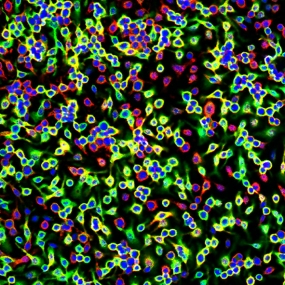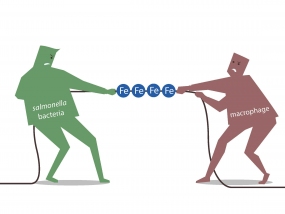Iron regulators join fight against pathogens
Proteins responsible for controlling levels of iron in the body also play an important role in combatting infection, according to a study published today in Cell Host & Microbe.

Fluorescence microscopy picture of bone marrow-derived macrophages: red: macrophage marker / blue: DNA /green: ferritin.
© Bruno Galy (DKFZ)
Humans – along with all living organisms, including pathogens – need iron to survive: invading organisms try to highjack it from their hosts in order to thrive and multiply. Researchers at EMBL Heidelberg, and their colleagues, have now discovered that proteins responsible for helping the body maintain the correct levels of iron at a cellular level are also involved in helping to prevent this theft. These proteins form a system called IRP/IRE (iron regulatory protein/iron responsive element).
“The work we’ve been doing has uncovered a connection between two very important functions that are typically seen as separate: the body’s innate immune system, and its iron metabolism,” explains Matthias Hentze, co-author of the paper and Director of EMBL.
The team analysed how mice reacted to an infection by the Salmonella bacteria, depending on whether they had a functional IRP/IRE system or not. Mice lacking a functional IRP/IRE system from professional immune cells called macrophages did well as long as they were not infected, but when the Salmonella bacteria were introduced, they died. This showed that the iron regulatory system was crucial for the macrophages, the target-cells for this specific pathogen, to fight off the infection effectively.
“Withholding iron from an invading pathogen is an innate defence against infection“, explains Bruno Galy, former Staff Scientist at EMBL-Heidelberg and currently group leader in the research division “Virus-Associated Carcinogenesis” of the German Cancer Research Centre (DKFZ) “Our study reveals that the IRP/IRE system plays an important role in this defence.”
The precise mechanisms through which the IRP/IRE system works in the macrophages will need further investigation, although the researchers have a number of theories.
One theory is that the IRP proteins help the macrophages produce a molecule called lipocalin 2, which is known to block bacteria from taking up iron from its host. Another idea is that the IRP/IRE system represses the expression of a protein called ferritin. Ferritin is present in cells as a kind of compartment to store iron until it is needed. Invading bacteria get access to these iron supplies and if the IRP proteins are not present, the cell will store much more iron than required – thus providing valuable nutrients for invaders.
The research was carried out in partnership with Guenter Weiss and colleagues at the Medical University of Innsbruck and Ferric Fang at the University of Washington.
The group now plans to carry out further investigations to find out if the IRP/IRE system is also important for other types of bacteria, and other types of infection, such as viruses or parasites. They also hope to discover if the IRP/IRE system has a role to play in other types of immune response, such as inflammation. This immune response is implicated in the progress of human diseases such as cancer or atherosclerosis so a better understanding of its mechanisms could have implications for research into new treatments.
Manfred Nairz, Dunja Ferring-Appel, Daniela Casarrubea, Thomas Sonnweber, Lydie Viatte, Andrea Schroll, David Haschka, Ferric C. Fang, Matthias W. Hentze, Guenter Weiss, and Bruno Galy: Iron Regulatory Proteins Mediate Host Resistance to Salmonella Infection: CELL Host & Microbe 2015. DOI: 10.1016/j.chom.2015.06.017
With more than 3,000 employees, the German Cancer Research Center (Deutsches Krebsforschungszentrum, DKFZ) is Germany’s largest biomedical research institute. DKFZ scientists identify cancer risk factors, investigate how cancer progresses and develop new cancer prevention strategies. They are also developing new methods to diagnose tumors more precisely and treat cancer patients more successfully. The DKFZ's Cancer Information Service (KID) provides patients, interested citizens and experts with individual answers to questions relating to cancer.
To transfer promising approaches from cancer research to the clinic and thus improve the prognosis of cancer patients, the DKFZ cooperates with excellent research institutions and university hospitals throughout Germany:
The DKFZ is 90 percent financed by the Federal Ministry of Education and Research and 10 percent by the state of Baden-Württemberg. The DKFZ is a member of the Helmholtz Association of German Research Centers.


